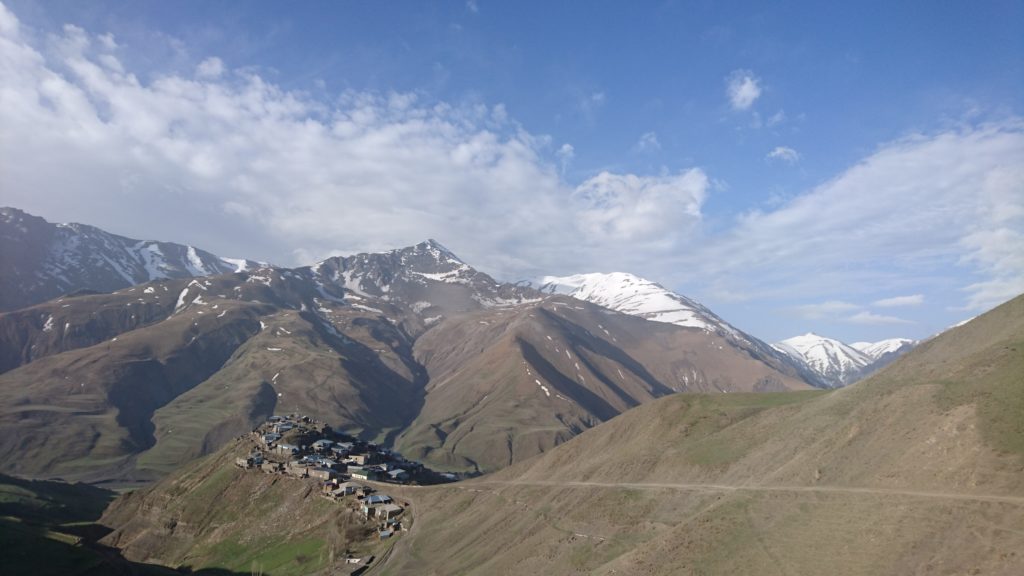James Parry takes a hike in the mountains of Azerbaijan in search of an endangered bird of prey with an unfair reputation and a very particular diet
We are heading for the uplands of the Greater Caucasus, and it’s clear that life up there is not for the faint-hearted. Snow covers the summits for much of the year and, even in summer, sudden storms can sweep down, blanketing the landscape in a view-blocking mix of rain, hail and mist. Driving inland from the Caspian Sea coast, myself and a small group of intrepid naturalists have our sights trained on the distant peaks. We pass through the town of Quba, famous for its fruit orchards, and then start climbing, following what turn into ever-narrower and more precipitous roads leading towards the mountains beyond. At one point, we thread our way through an epic gorge, with sheer cliffs soaring up on either side and the Guidalchay river foaming in torrents below us. It’s like a setting for the medieval fantasy epic Game of Thrones.
Once out of the canyon, we climb further and emerge onto an open, stony plain framed by snow-capped peaks reaching up to more than 4,000 metres. The landscape looks deserted, yet people live here all year-round – traditional farmers who for centuries have eked out a precarious living from sheep and goats and whatever limited crops they can grow in summer. Every so often we glimpse a stone-built village, emerging organically from the rocky landscape and seemingly unchanged for hundreds of years.
One such settlement is Xinaliq. Perched high on a ridge, it’s where we arrive just as darkness falls and it starts raining. Small children gather excitedly around our vehicles as we unload our bags into the traditional house that is our home for the night. A hearty mountain meal follows, and then bed. It’s an early start in the morning.

The village of Xinaliq in the Caucasus Mountains, Azerbaijan, from where James Parry hikes in search of the lammergeier (Image courtesy of Getty Images)
By dawn, the cloud has cleared and the sun is out – a huge relief. We have a full day’s hike planned and rain is not what we want. We are here to spot mountain birds, and I’m anxious to see one species in particular: the lammergeier, or bearded vulture. With a wingspan approaching three metres, a diamond-shaped tail that it uses as a rudder, and distinctive facial feathers that give it a ‘whiskered’ appearance reminiscent of a World War One pilot, this is a glider par excellence. But it needs good weather to be able to soar over the mountain landscape in search of food; in rain or low cloud, it does not even bother to take to the wing.
Lammergeiers are not easy birds to see at the best of times. Although widespread globally – from Spain eastwards across the Alps (where they were reintroduced), to the Balkans, Turkey and much of Central Asia, including the Himalayas, and parts of Africa – they aren’t common in any one place. In many countries their numbers are falling, and in some they are now extinct. On the brink of endangered status, they face many challenges, ranging from illegal persecution (poisoned bait put down to kill wolves inadvertently kills vultures, too) and collisions with electricity pylons and wind turbines, to human disturbance and habitat degradation.
In Azerbaijan, the lammergeier population remains relatively strong, with an estimated 50-100 pairs in the whole country, and in the area around Xinaliq we stand as good a chance of seeing one as anywhere – or so we have heard. But local people then tell us that they have not seen any for several days, and I begin to wonder if we are on something of a wild goose chase, so to speak. I recall reading somewhere that a pair of lammergeiers might range over a territory extending to as much as 300sq km, so this really is needle-in-haystack stuff. Somehow the omens don’t feel good.
Historically, humans and lammergeiers have had a difficult relationship. Like any large bird with a hooked bill and talons, they have attracted the suspicion and wrath of shepherds, fearful for their flocks. The word Lämmergeier is German for ‘lamb vulture’, and mountain folklore is full of stories of the ‘dragon of the sky’ sweeping down to carry off livestock and even small children. Yet there are no verified accounts of this happening, and lammergeiers are now known to be overwhelmingly carrion feeders. Only very occasionally will they take live prey, and then almost certainly it will be an animal that is already mortally wounded.
Lammergeiers specialize in eating bones and are very partial to the marrow inside. To obtain this, they fly up with the bones and drop them from a height onto rocks below, smashing them into smaller, more manageable, pieces that they can spiral down to crunch and swallow. It’s a technique I really wanted to see, but care is required. The ancient Greek dramatist Aeschylus is said to have been killed when a lammergeier dropped a tortoise onto his bald head, which it had mistaken for a rock. But like many myths surrounding this bird, this is almost certainly not true!
Three hours into our hike and still no luck. Scanning the skyline, we see only ravens circling around. I start to feel a bit despondent, but then our spirits are lifted as a golden eagle sails into view, powerful and majestic. Suddenly, the eagle moves off at speed, clearly spooked. Something even bigger appears in its place, head-on at first, but then turning to reveal that distinctively shaped tail – finally, a lammergeier! Spellbound, we watch as it effortlessly rides the thermals, barely flapping its wings as it scours the alpine meadows below. Then it drops down, out of view behind a small outcrop. We wait, wondering if that was that.
It reappears, gaining height rapidly, and I notice that in its beak it is carrying what looks like a rib bone. Up and up it goes, ever higher, until all of a sudden it stalls, releasing the bone, which tumbles to the ground below and bounces off the rocky scree. Time for the lammergeier to feed, and for us to celebrate a truly fantastic sighting. It’s not often that wildlife performs on cue for an audience, but, on this occasion, the king of the vultures did exactly what it says on the tin.

The High Caucasus village of Xinaliq, in the heart of Lammergeier territory (Photography by Emil Lundahl)
Photography courtesy of Getty Images, Emil Lundahl and Emil Khalilov







